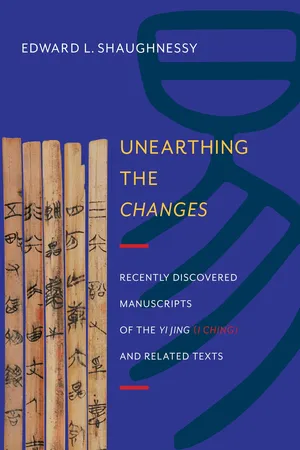
Unearthing the Changes
Recently Discovered Manuscripts of the Yi Jing (I Ching) and Related Texts
- English
- ePUB (mobile friendly)
- Available on iOS & Android
Unearthing the Changes
Recently Discovered Manuscripts of the Yi Jing (I Ching) and Related Texts
About this book
In recent years, three ancient manuscripts relating to the Yi jing (I Ching), or Classic of Changes, have been discovered. The earliest—the Shanghai Museum Zhou Yi—dates to about 300 B.C.E. and shows evidence of the text's original circulation. The Guicang, or Returning to Be Stored, reflects another ancient Chinese divination tradition based on hexagrams similar to those of the Yi jing. In 1993, two manuscripts were found in a third-century B.C.E. tomb at Wangjiatai that contain almost exact parallels to the Guicang's early quotations, supplying new information on the performance of early Chinese divination. Finally, the Fuyang Zhou Yi was excavated from the tomb of Xia Hou Zao, lord of Ruyin, who died in 165 B.C.E. Each line of this classic is followed by one or more generic prognostications similar to phrases found in the Yi jing, indicating exciting new ways the text was produced and used in the interpretation of divinations.
Unearthing the Changes details the discovery and significance of the Shanghai Museum Zhou Yi, the Wangjiatai Guicang, and the Fuyang Zhou Yi, including full translations of the texts and additional evidence constructing a new narrative of the Yi jing's writing and transmission in the first millennium B.C.E. An introduction situates the role of archaeology in the modern attempt to understand the Classic of Changes. By showing how the text emerged out of a popular tradition of divination, these newly unearthed manuscripts reveal an important religious dimension to its evolution.
Frequently asked questions
- Essential is ideal for learners and professionals who enjoy exploring a wide range of subjects. Access the Essential Library with 800,000+ trusted titles and best-sellers across business, personal growth, and the humanities. Includes unlimited reading time and Standard Read Aloud voice.
- Complete: Perfect for advanced learners and researchers needing full, unrestricted access. Unlock 1.4M+ books across hundreds of subjects, including academic and specialized titles. The Complete Plan also includes advanced features like Premium Read Aloud and Research Assistant.
Please note we cannot support devices running on iOS 13 and Android 7 or earlier. Learn more about using the app.
Information


Table of contents
- Cover
- Editorial Board
- Title Page
- Series Page
- Copyright
- Dedication
- Contents
- List of Illustrations
- List of Tables
- Preface
- Acknowledgments
- 1. Divining the Past Divining the Future: Archaeology and the Rediscovery of the Changes
- 2. The Context, Content, and Significance of the Shanghai Museum Manuscript of the Zhou Yi
- 3. Translation of the Shanghai Museum Manuscript of the Zhou Yi
- 4. The Wangjiatai Bamboo-Strip Manuscripts of the Gui cang
- 5. Translation of the Gui cang Fragments
- 6. The Fuyang Zhou Yi Manuscript
- 7. Translation of the Fuyang Zhou Yi Manuscript
- Conclusions and Conjectures
- Notes
- Works Cited
- Index
- Series List